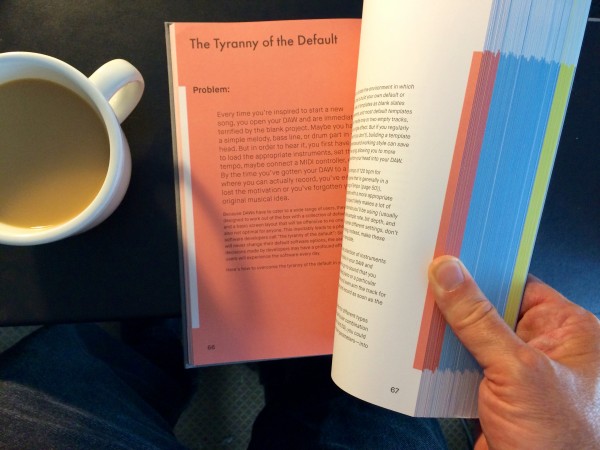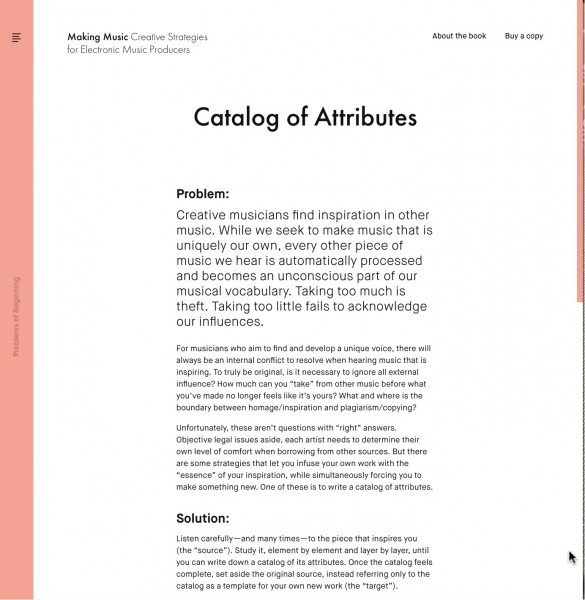A Review of Making Music: 74 Strategies for Electronic Music Producers

One of the books on my bookshelf isn't a book at all. It's a deck of cards. The Oblique Strategies (developed in the 1970s by Brian Eno and his teacher pal Peter Schmidt and still available) is oracular in the sense that the I Ching is: you consult it by drawing a card when you're in a jam (revealing a saying such as "Honor thy error as a hidden intention"). While I have used and loved the deck for many years (I've even curated a website that's sufficiently ancient that it could use a facelift but still contains lots of useful information), there's often a problem with oracles. They can be unspeakably opaque or puzzling, and often don't appear to have any connection to the question or problem at hand. They're well... oracular.
I think that's because our dilemmas as creative people live somewhere between strategy and tactics. My bookshelf has plenty of good examples of books about tactics/implementation, and I've talked about some of them here and here and here. My bookshelf contains fewer examples of books that direct your attention to the idea of creative strategies (I'd recommend Tyler Volk's Metapatterns and Christopher Alexander's The Phenomenon of Life from his series The Nature of Order here), and fewer still that strive to bridge the area between the what and the how.
Dennis DeSantis' book Making Music: 74 Strategies for Electronic Music Producers is a book that's taken up residence on my shelf (first as a Kindle edition, and - because I am a lover of books whose design and typography are a delight - now as a physical object) and has proven to be the kind of book that inspires, nudges, and aims me in different directions as I work.
Any description of the book I'd give you would start with telling you what it isn't - it strives mightily to be both genre-neutral (it's neither about making N-bpm techno nor electroacoustic work) and software-neutral (although the illustrations are screenshots from Ableton Live, you can use it alongside any DAW you've got). You won't discover much about how to mike a drumkit or spatialize wavelets, either. Instead, the book is divided into three sections concerned with challenges related to the creation of music: starting, finishing, and – crucially – what comes between (In case you’re curious about the balance of chapters, I counted: There are 25 Beginning sections, 12 on Finishing, and 37 sections in the middle. Meditate on that....). Each of the 74 sections is presented in a problem – solution format, where both the problem and solution are elaborated upon in ways that often steer the creative reader away from the tendency to opt for efficiency or the idea that there is a single solution.
Each of the problem/solution sections are compact, bite-sized, and digestable. The extent to which any given insight of the 74 will be inspiring or novel or revelatory will vary from reader to reader, of course (His cheerful pragmatism leads him to some courageous undertakings, as well, as witnessed by the three middle chapters dedicated to music theory. What you find there may not be of great use for your Second Viennese School IDM or doing Bebop harmonic substitutions on the tune for “Full Moon and Empty Arms,” but it will definitely give you some practical ways to start breaking your addiction to I-VII-IV or I-IV-V, should you have one). As with any transactional relationship (be it guru, therapist, or teacher), some of what you read may seem disarmingly obvious at first sight. But like the humble amino acids that make up a protein molecule, their secret lies in how they fold. I expect that everyone will find something within that – if one is honest and humble – will prove to be a benefit to capture and benefit from moments of inspiration with greater ease and clarity.

At its best, the book properly recognizes that there is a curve to the creative process - one in which vexations morph as things progress - and encapsulates a practical set of instructive dilemmas and possible "things to do next" intended to guide and focus your own thinking on the practice of making music throughout the process from start to finish. In the sense that the Solution sections of the book seeks to translate questions of strategy to methods of work (yes, tactics), the book occupies an interesting and, I think, somewhat unique category. I'm sure everyone will use it differently - I read it cover to cover in pieces initially, and - in the process of using it, have been surprised to discover that I've come to focus on those situations where Dennis refers to the ways in which the book's solutions intertwine or connect (rather in the way that the patterns of building and living in Christopher Alexander's A Pattern Language interconnect to create a larger web of ideas).
If you're curious, the book's website includes several readable chapters online that should help you get a feel for the overall work. I hope you'll find it an enjoyable and helpful addition to your music creation bookshelf.
by Gregory Taylor on July 12, 2016

